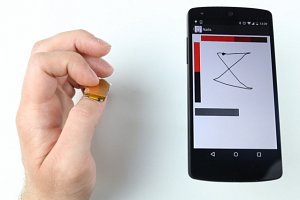Thumbnails become miniature wireless trackpad: the wearable innovation that may change the way we use technology

Researchers belonging to the MIT Media Laboratory are currently developing a new wearable device capable of turning the users’ thumbnails into an alternative wireless track pad. The technology may help controlling devices when the hands are full and the user is busy doing specific tasks.
The researcher involved in the study predict that the technology could allow users to control wirelessly devices while busy with their hands full – for tasks such as answering to the phone while cooking, for example. Furthermore, it could be connected to other interfaces, allowing users texing on a smartphone to browse begweem symbols without needing to interrupt the typing activity. Finaly, it could allow subtle communication in special circumsrances, such as sending a quick text to a family member while attending a meeting.
The researchers presented a paper with the description of the prototype called NailO at the Association for Computing Machinery’s Computer-Human Interaction conference in Seoul.
One the new paper’s lead authors, the MIT graduate student in media arts and sciences Cindy Hsin-Liu Kao, explained that the device was inspired by the colorful stickers that women like to apply to their nails. “It’s a cosmetic product, popular in Asian countries,” explained Kao, who is Taiwanese. “When I came here, I was looking for them, but I couldn’t find them, so I’d have my family mail them to me.”
The researchers predict that the commercial versions of their new device would allow a detachable cover membrane on the surface, allowing users to coordinate device appearance and outfits. The device uses capacitive sensing, similar to the iPhone’s touch screen sensing systems, to register touch, since it can tolerate a nonactive thin layer between underlying sensors and users’ fingers.
Fast and Easy Access
Thumbnails have different advantages. They have a hard surface and no nerve ending, allowing the affixed device to work well without causing discomfort or impairing movements.
Kao explained: “It’s very unobtrusive […] When I put this on, it becomes part of my body. I have the power to take it off, so it still gives you control over it. But it allows this very close connection to your body.”
To build the first device, the challenge involved the research of a method to pack battery, capacitive sensors, and three separate chips (a capacitive-sensing chip, a Bluetooth radio chip and a microcontroller) into a space fitting a thumbnail. Artem Dementyev, one of the paper’s lead authors said “The hardest part was probably the antenna design’ […] You have to put the antenna far enough away from the chips so that it doesn’t interfere with them.”
Kao and Dementyev were supported in the paper by their advisor, research scientist Chris Schmandt, and Joe Paradiso, associate professor of media arts and sciences. Dementyev and Paradiso took care of the circuit design, while Kao and Schmandt focused on the software that receives and interprets the signal from the capacitive sensors, filters out noise and translates the signal into movements on screen. The first prototype presented sensors built by printing copper electrodes on sheets of flexible polyester, which allowed the researchers to test and experiment with a variety of different electrode layouts. However, on the actual experiments, researchers are using specific sheets of electrodes like the ones found in some track pads.
Slim and Cool
The researchers have been discussing about the battery, travelling to China to meet some manufacturers and, apparently, they found a technology at could yield a battery that is only half a millimetre thick and fits in the space of a thumbnail. Furthermore, the researchers are working on a specific chip that combines the functions of micro-controller, radio and capacitive sensor, which would allow further space saved.
In such small space, however, the energy efficiency is limited. Therefore, the device would have to be switched off when not used. The paper also discussed about the required time for activating and deactivating the device, concluding that holding the surface for a period of two/three seconds would be enough to switch off/on the device preventing involuntary activation and deactivation. Steve Hodges, who leads the Sensors and Devices group at Microsoft Research in Cambridge, England said:”Keyboards and mice – still – are not going away anytime soon,”[…] “But more and more that’s being complemented by use of our devices and access to our data while we’re on the move. I’ve got desktop, I’ve got a mobile phone, but that’s still not enough. Different ways of displaying and controlling devices while we’re on the go are, I believe, going to be increasingly important.”
“Is it the case that we’ll all be walking around with digital fingernails in five years’ time?” Hodges wondered. “Maybe it is. Most likely, we’ll have a little ecosystem of these input devices. Some will be audio based, which is completely hands free. But there are a lot of cases where that’s not going to be appropriate. NailO is interesting because it’s thinking about much more subtle interactions, where gestures or speech input are socially awkward.”
Written by: Pietro Paolo Frigenti
